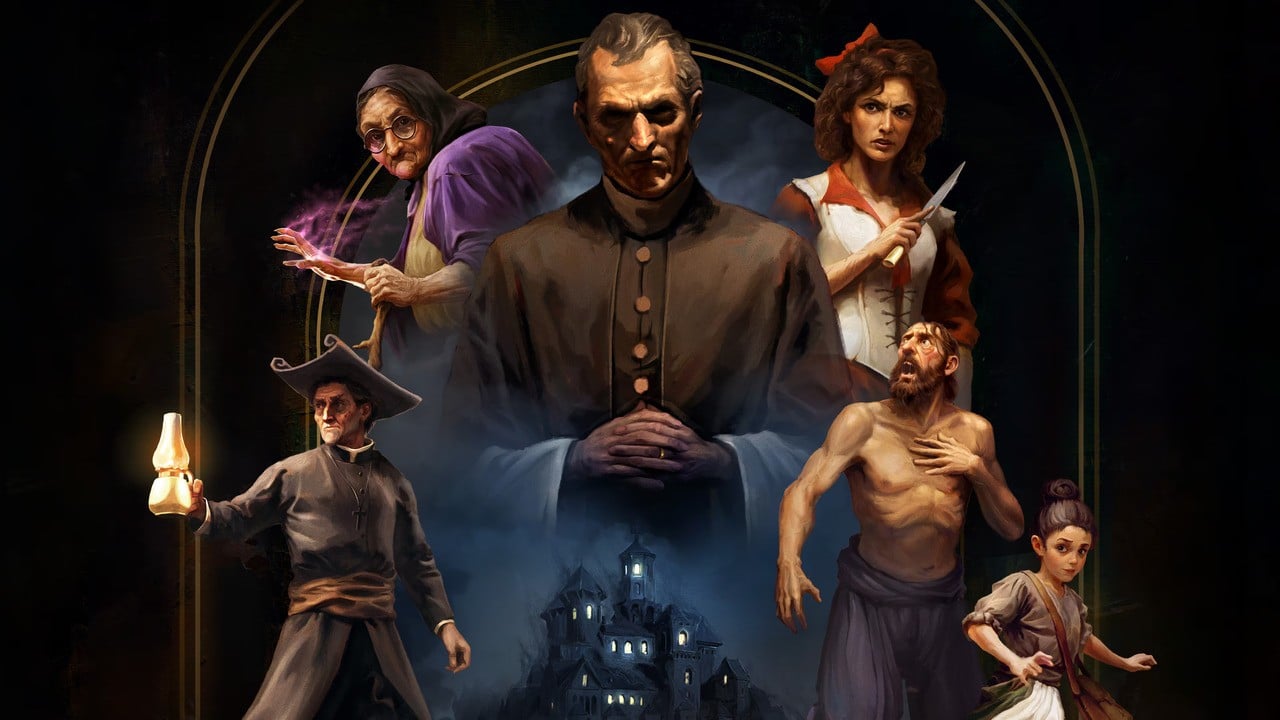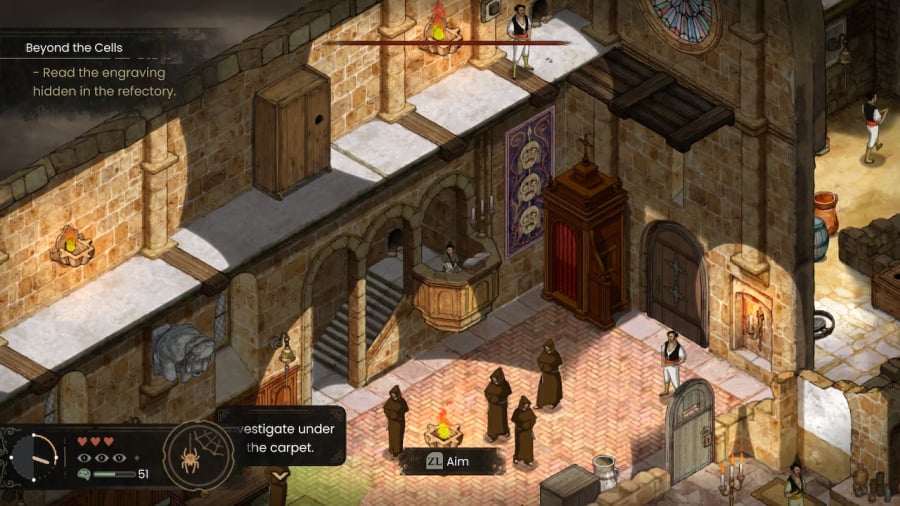

If you ever thought monasteries were just devoted to worship, feasting abbots, and choral chants of Ave Maria, The Stone of Madness is set on proving you dead wrong.
This is The Game Kitchen’s first foray into the stealth-tactics genre (a distinctly Spanish obsession we discussed with the devs last year) after the team’s stellar work with the Blasphemous Metroidvanias. Two separate campaigns take place in an imposing 1800s Pyrenees monastery, which doubles as an insane asylum. This mountaintop prison offers no redemption, nor escape from earthly woes, for five luckless inmates aiming to escape, or destroy, their captors.
The hospitality of these cruel nuns and friars may feel as cold and stony as the slabs making up the monastery’s walls, but we still marvelled at this sordid Jesuit asylum that drips with the Spanish Inquisition’s cruelty and sorrow. A magnificent stealth sandbox, hand painted in rich gothic atmosphere and Catholic pageantry, creates a reactive simulation of its daily operations: Fretful inmates roam common areas. Nuns and friars tend herb gardens, wash laundry, or attend to holy study under fearsome inquisitors and mother superiors. When the clock chimes three o’clock, monks march from their Angelus prayers from the chapel into the dining hall. Upon nightfall dreadful anima spirits stalk the halls.

The strikes of patrolling guards and the alarms of passing clergy may be your biggest concern, but your own capabilities come a close second. Limited to a team of three, as in Commandos or Shadow Tactics, your inmates’ path is defined by their abilities.
Some skills are conventional; the strong knock out guards and stuff them into the closest wardrobe, the small pickpocket keys and other goodies before sliding through narrow crevices unnoticed. Others are more creative, and impressive: a witch hexes guards into tripping when giving chase, a child provokes guards to abandon their posts by blowing a cheeky raspberry before leading them to plant a foot onto an awaiting mousetrap. At its best, it’s like a morbidly madcap Scooby Doo adventure full of chases and unexpected twists.
Surprisingly, we found the creative use of barriers as memorable as our abilities. If tasked with speaking to a nun then don’t use Eduardo – the gentle mute can’t utter a word. And a pile of papers holds many secrets, but that’s no use to the child Amelia who’s yet to learn to read. There are many routes, though only a few usable at any time. It’s an immersive-sim-inspired recipe for improvisation, and the set-up for many, many accidents waiting to happen.

And that’s only the start. In a frightful twist, one mechanic is designed to make us even more accident-prone: each character begins the game with a phobia. Whenever triggered, their sanity plummets. Alfredo the priest can’t bear the sight of violence, or its results in the form of corpses or unconscious bodies. Eduardo is afraid of the dark. Meanwhile, Leonara may serve as the group’s muscle but she can’t face an open flame.
This approach results in a doom spiral from levels that make you confront your worst nightmares. Does Eduardo sprint through an unlit corridor at a dreadful cost or wait for Alfredo to accompany him with his oil lamp? A treasure chest in a dark room full of corpses deters the squeamish, and if you have a headache then better avoid the noisy piano player.
Even worse, if your sanity hits zero you’re knocked out for the day with an all-new phobia for your trouble. After being afflicted with rheumatism, Agnes spent much of our playthrough unable to sprint; Eduardo became claustrophobic and refused to hide in cupboards. With our options constricted, more mishap awaits.

The Stone of Madness’s day-night cycle creates a sense of an ongoing escape plot. By night you plan, craft makeshift tools, heal your wounds, and soothe your fractured minds. By day, the clock ticking, you act. It’s a partial reset, an opportunity to reconfigure your party and equipment almost befitting a roguelite. With no objective timer, the situation is dire but the pressure is low. Messed up? Try again tomorrow.
This forgiving attitude is why you won’t find a manual save system, or a game over failstate, in a commendable bid to solve stealth tactics’ longstanding reliance on save-scumming. But we did find ourselves quitting and reloading saves as a result of the game’s biggest issue: its intimidating difficulty.
When the game takes the guardrails off, our most devious plots weren’t always matched by the ability to find a path forward, or execute our plan once we’d found a way forward.
The information breadcrumbs towards your objective sometimes feel obscure, too easily missed – even with hints turned on we struggled with one quest to collect several mandrakes with frustratingly elusive solutions. And the monastery’s subterranean crypts, stately cloisters, and winding passages make for dramatic levels, but at the cost of narrowing the open space to avoid line of sight or find refuge in the shadows. When guard patrols and formidable special characters are at large in forbidden areas, challenges like carrying a single plank of wood to create a makeshift bridge to reach the abbot’s quarters feel near impossible.

These wouldn’t be an issue without an unintended consequence of the day-night cycle. On normal difficulty, when things get bad, or you take too long to advance, it takes time to recover when resources dwindle. On several occasions, our suspicious misdeeds left heightened guard patrols wherever we needed to break in, our psyches so fragile just one fright left us bedridden. Accident befell us all too easily.
More unhappy accidents. We noticed some performance issues, including frame-rate slowdown in crowded scenes and, in docked mode, the game’s impeccable art style was held back by blurry textures. There were a number of glitches in our playthrough, too. Troublingly, an introduction to a pianist froze the game entirely, forcing a restart to a save that the game told us was from several hours before! Fortunately, it had miscounted – one of a number of glitches we encountered in our time with the game.
We also missed quality-of-life features and some recent genre innovations. No AI commands or options to pause and queue actions by multiple characters simultaneously like Shadow Mode from Shadow Tactics. Instead, outside of an imperfect follow/unfollow command that resets when you go to a new area, you tab between characters and do it all manually.

This busywork spoils the remarkable heist fantasy achieved in so many other ways, and creates too many windows for guards or phobias to strike. As Alfredo may utter in one of his guard-distracting sermons, the spirit is willing but the flesh (or at least our thumbs’ reflexes) is weak.
Conclusion
For all its sins, there’s the makings of a stealth-tactics classic in The Stone of Madness. Its grisly sensibility, rock-hard difficulty, and inconvenient bugs at launch mean it’s not a game for the weak-hearted, but 20+ hours with its rich, system-driven drama produced many delightful escapades worth admiring – even if a good number ended with us back in our cell miserably plotting our next attempt.

If you ever thought monasteries were just devoted to worship, feasting abbots, and choral chants of Ave Maria, The Stone of Madness is set on proving you dead wrong.
This is The Game Kitchen’s first foray into the stealth-tactics genre (a distinctly Spanish obsession we discussed with the devs last year) after the team's stellar work with the Blasphemous Metroidvanias. Two separate campaigns take place in an imposing 1800s Pyrenees monastery, which doubles as an insane asylum. This mountaintop prison offers no redemption, nor escape from earthly woes, for five luckless inmates aiming to escape, or destroy, their captors.
The hospitality of these cruel nuns and friars may feel as cold and stony as the slabs making up the monastery’s walls, but we still marvelled at this sordid Jesuit asylum that drips with the Spanish Inquisition’s cruelty and sorrow. A magnificent stealth sandbox, hand painted in rich gothic atmosphere and Catholic pageantry, creates a reactive simulation of its daily operations: Fretful inmates roam common areas. Nuns and friars tend herb gardens, wash laundry, or attend to holy study under fearsome inquisitors and mother superiors. When the clock chimes three o’clock, monks march from their Angelus prayers from the chapel into the dining hall. Upon nightfall dreadful anima spirits stalk the halls.

The strikes of patrolling guards and the alarms of passing clergy may be your biggest concern, but your own capabilities come a close second. Limited to a team of three, as in Commandos or Shadow Tactics, your inmates’ path is defined by their abilities.
Some skills are conventional; the strong knock out guards and stuff them into the closest wardrobe, the small pickpocket keys and other goodies before sliding through narrow crevices unnoticed. Others are more creative, and impressive: a witch hexes guards into tripping when giving chase, a child provokes guards to abandon their posts by blowing a cheeky raspberry before leading them to plant a foot onto an awaiting mousetrap. At its best, it’s like a morbidly madcap Scooby Doo adventure full of chases and unexpected twists.
Surprisingly, we found the creative use of barriers as memorable as our abilities. If tasked with speaking to a nun then don’t use Eduardo - the gentle mute can’t utter a word. And a pile of papers holds many secrets, but that’s no use to the child Amelia who’s yet to learn to read. There are many routes, though only a few usable at any time. It’s an immersive-sim-inspired recipe for improvisation, and the set-up for many, many accidents waiting to happen.

And that’s only the start. In a frightful twist, one mechanic is designed to make us even more accident-prone: each character begins the game with a phobia. Whenever triggered, their sanity plummets. Alfredo the priest can’t bear the sight of violence, or its results in the form of corpses or unconscious bodies. Eduardo is afraid of the dark. Meanwhile, Leonara may serve as the group’s muscle but she can’t face an open flame.
This approach results in a doom spiral from levels that make you confront your worst nightmares. Does Eduardo sprint through an unlit corridor at a dreadful cost or wait for Alfredo to accompany him with his oil lamp? A treasure chest in a dark room full of corpses deters the squeamish, and if you have a headache then better avoid the noisy piano player.
Even worse, if your sanity hits zero you’re knocked out for the day with an all-new phobia for your trouble. After being afflicted with rheumatism, Agnes spent much of our playthrough unable to sprint; Eduardo became claustrophobic and refused to hide in cupboards. With our options constricted, more mishap awaits.

The Stone of Madness’s day-night cycle creates a sense of an ongoing escape plot. By night you plan, craft makeshift tools, heal your wounds, and soothe your fractured minds. By day, the clock ticking, you act. It’s a partial reset, an opportunity to reconfigure your party and equipment almost befitting a roguelite. With no objective timer, the situation is dire but the pressure is low. Messed up? Try again tomorrow.
This forgiving attitude is why you won’t find a manual save system, or a game over failstate, in a commendable bid to solve stealth tactics’ longstanding reliance on save-scumming. But we did find ourselves quitting and reloading saves as a result of the game’s biggest issue: its intimidating difficulty.
When the game takes the guardrails off, our most devious plots weren’t always matched by the ability to find a path forward, or execute our plan once we’d found a way forward.
The information breadcrumbs towards your objective sometimes feel obscure, too easily missed - even with hints turned on we struggled with one quest to collect several mandrakes with frustratingly elusive solutions. And the monastery’s subterranean crypts, stately cloisters, and winding passages make for dramatic levels, but at the cost of narrowing the open space to avoid line of sight or find refuge in the shadows. When guard patrols and formidable special characters are at large in forbidden areas, challenges like carrying a single plank of wood to create a makeshift bridge to reach the abbot’s quarters feel near impossible.

These wouldn’t be an issue without an unintended consequence of the day-night cycle. On normal difficulty, when things get bad, or you take too long to advance, it takes time to recover when resources dwindle. On several occasions, our suspicious misdeeds left heightened guard patrols wherever we needed to break in, our psyches so fragile just one fright left us bedridden. Accident befell us all too easily.
More unhappy accidents. We noticed some performance issues, including frame-rate slowdown in crowded scenes and, in docked mode, the game’s impeccable art style was held back by blurry textures. There were a number of glitches in our playthrough, too. Troublingly, an introduction to a pianist froze the game entirely, forcing a restart to a save that the game told us was from several hours before! Fortunately, it had miscounted - one of a number of glitches we encountered in our time with the game.
We also missed quality-of-life features and some recent genre innovations. No AI commands or options to pause and queue actions by multiple characters simultaneously like Shadow Mode from Shadow Tactics. Instead, outside of an imperfect follow/unfollow command that resets when you go to a new area, you tab between characters and do it all manually.

This busywork spoils the remarkable heist fantasy achieved in so many other ways, and creates too many windows for guards or phobias to strike. As Alfredo may utter in one of his guard-distracting sermons, the spirit is willing but the flesh (or at least our thumbs’ reflexes) is weak.
Conclusion
For all its sins, there’s the makings of a stealth-tactics classic in The Stone of Madness. Its grisly sensibility, rock-hard difficulty, and inconvenient bugs at launch mean it’s not a game for the weak-hearted, but 20+ hours with its rich, system-driven drama produced many delightful escapades worth admiring - even if a good number ended with us back in our cell miserably plotting our next attempt.






